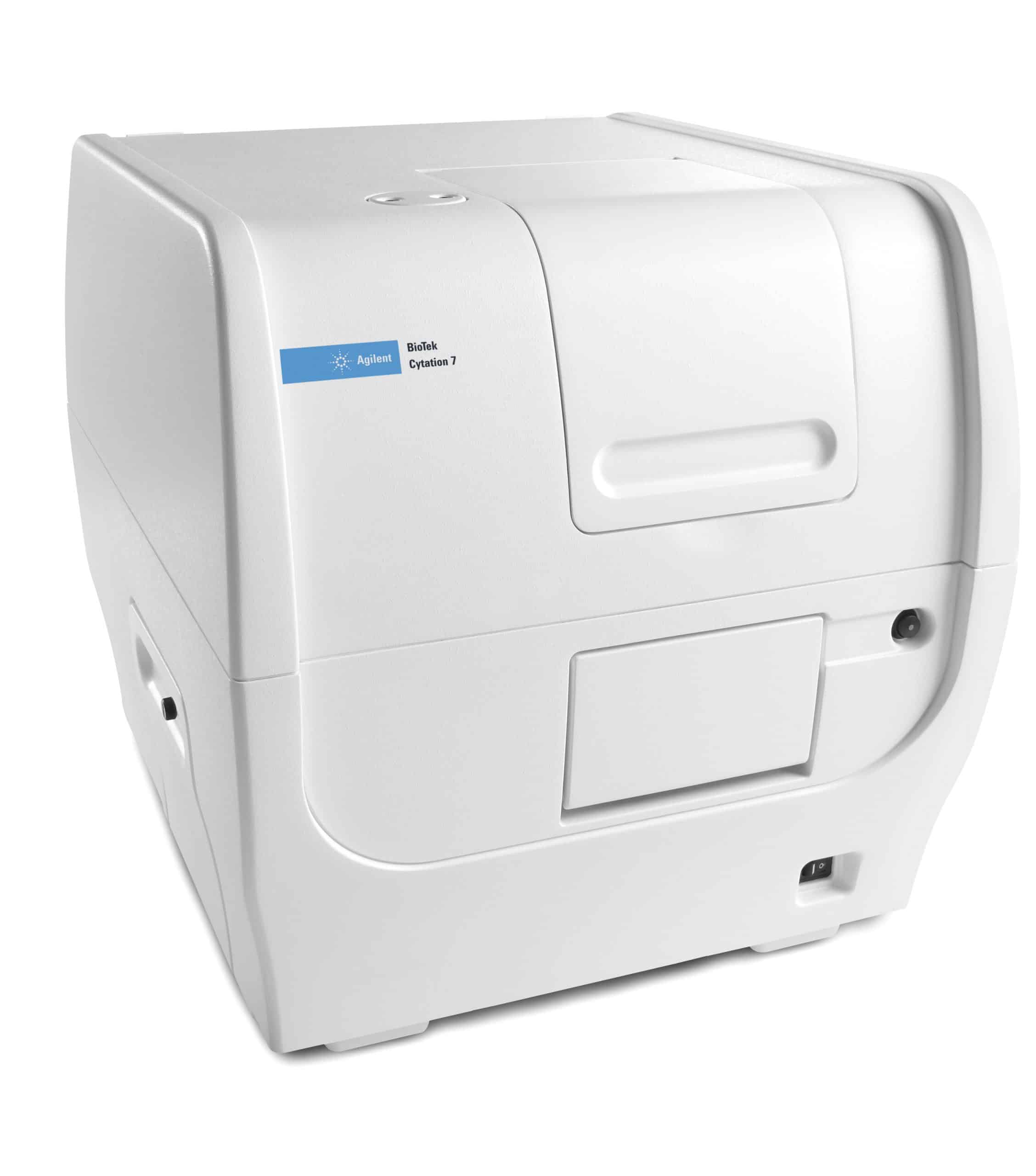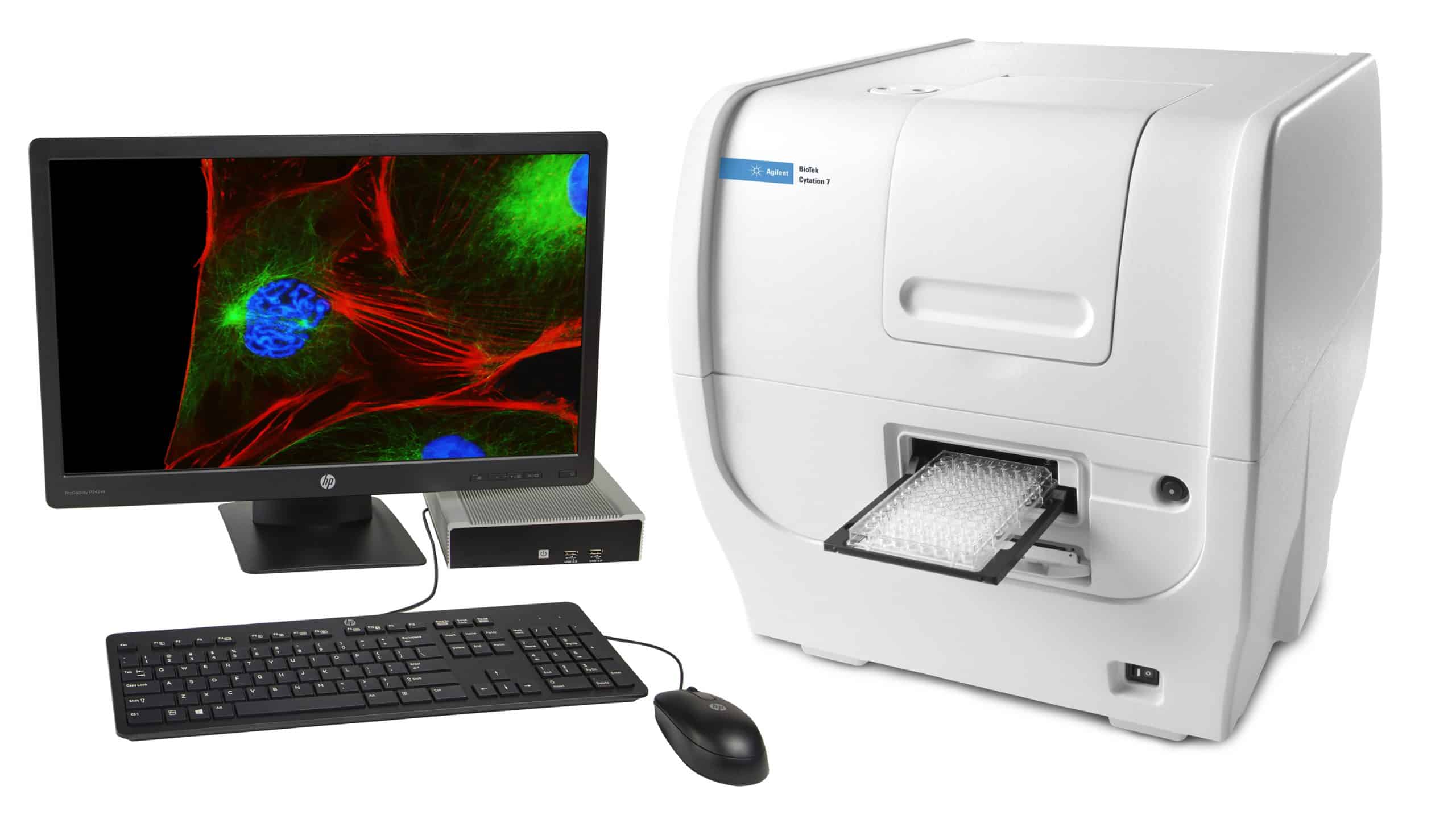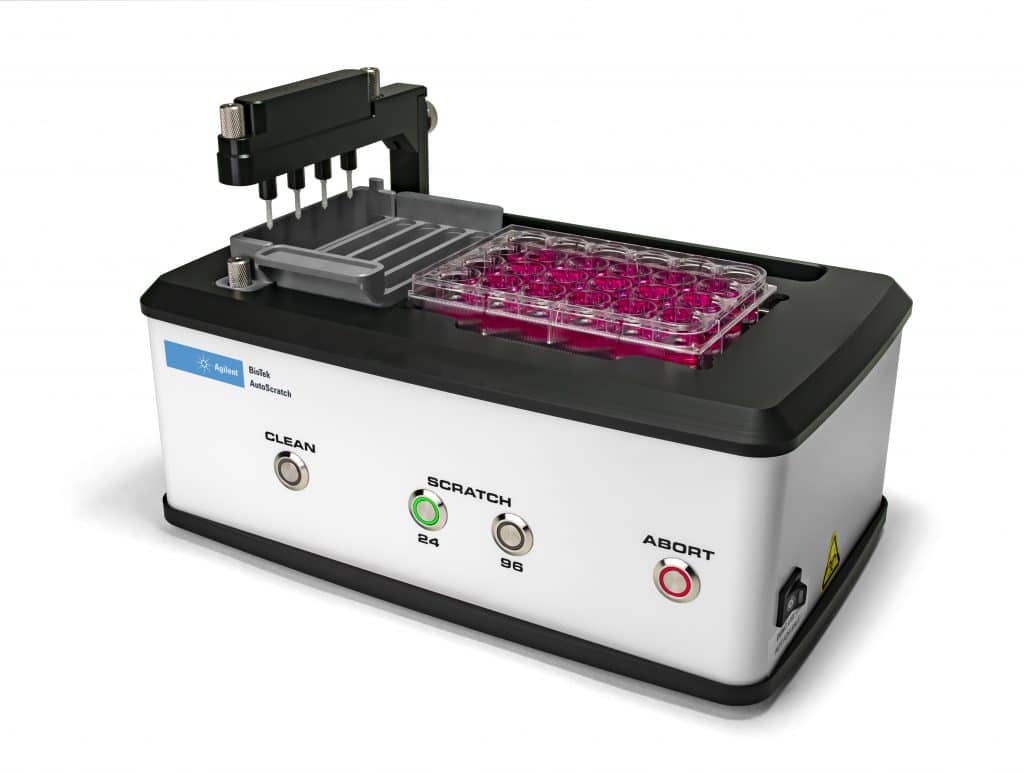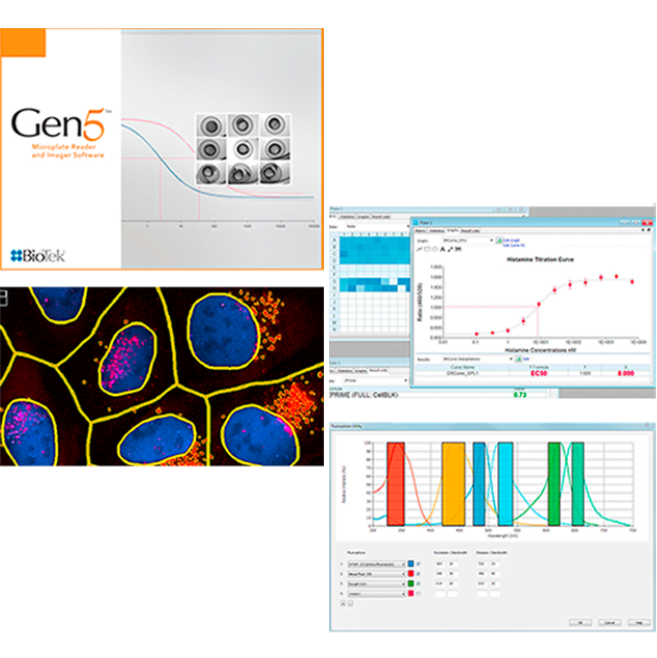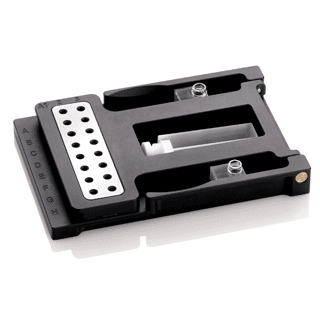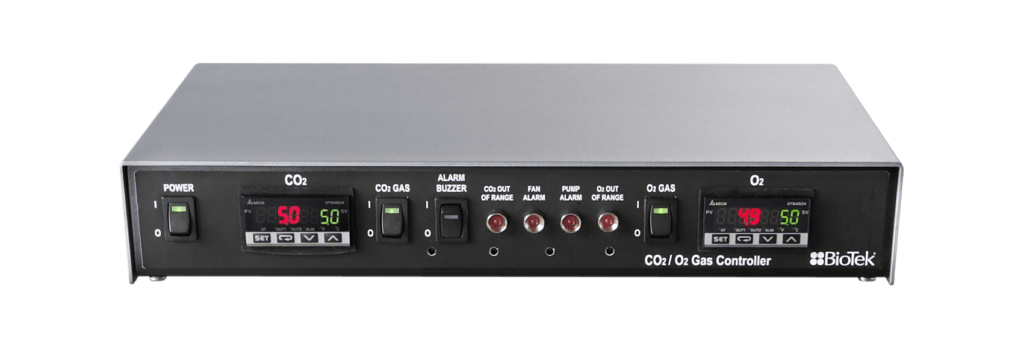BioTek Cytation 7
Information
Cytation7 Cell Imaging Multi-Mode Reader combines automated digital upright and inverted widefield microscopy with conventional multi-mode microplate reading in a unique, modular patented design. The upright microscopy module with reflected and transmitted light imaging enables even more applications such as ELISpot, Colony counting, material inspection and fast slide scanning in combination with region of interest (ROI) detection workflow.
Configurations
In total, we offer five microscopes that are all available in multiple configurations to meet the specific criteria of your lab. The Cytation systems are the most modular and flexible imaging systems on the market, as they come as they are available as:
- Imaging Only System, upgradable for plate reader capabilities
- Multi-mode reader Only System, upgradable for imaging
- Imaging & Multi-Mode Reader System as one compact platform
-
Cytation range
Cytation 7 Cytation 5 Cytation 1 General Detection modes UV-Vis absorbance UV-Vis absorbance UV-Vis absorbance Fluorescence intensity Fluorescence intensity Fluorescence intensity Luminescence Luminescence Luminescence Fluorescence polarization Fluorescence polarization Time-resolved fluorescence Time-resolved fluorescence Alpha Read methods Endpoint, kinetic, spectral scanning, well area scanning Endpoint, kinetic, spectral scanning, well area scanning Endpoint, kinetic, spectral scanning, well area scanning Microplate types Monochromator: 6- to 384-well plates Monochromator: 6- to 384-well plates Monochromator: 6- to 384-well plates Imaging: 6- to 1536-well plates Filters: 6- to 1536-well plates Filters: 6- to 1536-well plates Imaging: 6- to 1536-well plates Imaging: 6- to 1536-well plates Other labware supported Microscope slides, Petri and cell culture dishes, cell culture flasks (T25), counting chambers (hemocytometer) Microscope slides, Petri and cell culture dishes, cell culture flasks (T25), counting chambers (hemocytometer) Microscope slides, Petri and cell culture dishes, cell culture flasks (T25), counting chambers (hemocytometer) Take3 Micro-Volume Plates Take3 Micro-Volume Plates Take3 Micro-Volume Plates Temperature control 4-Zone incubation to 45 °C with Condensation Control; 4-Zone incubation to 65 °C with Condensation Control; 4-Zone incubation to 45 °C with Condensation Control™; +0.5 °C at 37 °C +0.2 °C at 37 °C Variation +0.2 °C at 37 °C Cooling Optional Peltier Cooling Module maintains internal temperature with < 1 °C rise over ambient. Provides internal cooling after incubated processes. Optional Peltier Cooling Module maintains internal temperature with < 1 °C rise over ambient. Provides internal cooling after incubated processes. Optional Peltier Cooling Module maintains internal temperature with < 1 °C rise over ambient. Provides internal cooling after incubated processes. Shaking Linear, orbital, double orbital Linear, orbital, double orbital Linear, orbital, double orbital Software Gen5™ Microplate Reader and Imager Software included Gen5™ Microplate Reader and Imager Software Gen5™ Microplate Reader and Imager Software Gen5 Secure for 21 CFR Part 11 compliance (option) Gen5 Image+ and Image Prime software available for full image analysis Gen5 Image+ and Image Prime software available for full image analysis Gen5 Secure available for 21 CFR Part 11 Gen5 Secure for 21 CFR Part 11 compliance (option) Automation BioStack and 3rd party automation compatible BioStack and 3rd party automation compatible BioStack and 3rd party automation compatible BioSpa 8 Automated Incubator compatible BioSpa 8 Automated Incubator compatible BioSpa 8 Automated Incubator compatible CO2 and O2 control (option) Range: 0 – 20% (CO2); 1 – 19% (O2) Range: 0 – 20% (CO2); 1 – 19% (O2) 0 – 20% CO2 control and 1 – 19% O2 control, with optional Gas Controller Models for both CO2 and O2 or CO2 only are available Models for both CO2 and O2 or CO2 only are available Models for both CO2 and O2 or CO2 only are available Imaging – Inverted Microscope Imaging mode Fluorescence, color brightfield, user-selectable brightfield/high contrast brightfield Fluorescence, brightfield, high contrast brightfield, color brightfield and phase contrast Fluorescence and high contrast brightfield (2.5x Zeiss, 4x, 10x, 20x, 40x and 60x) Imaging method Single color, multi-color, time lapse, montage, z-stacking, z-stack montage Single color, multi-color, montage, time lapse, z-stacking Single color, multi-color, montage, time lapse, z-stacking Image processing Z-projection, digital phase contrast, stitching Z-projection, digital phase contrast, stitching Z-projection, image stitching Camera 16-bit Sony CMOS wide field of view monochrome camera 16-bit Sony CMOS, standard or wide FOV 16-bit gray scale, Sony Objective capacity 6-position automated turret for user-replaceable objectives 6-position automated turret for user-replaceable objectives 2 user-replaceable objectives Objectives available 1.25x, 2.5x (2.25x eff),2.5x (2.75x eff), 4x,10x, 20x, 40x, 60x 1.25x, 2.5x (2.25x eff),2.5x (2.75x eff), 4x,10x, 20x, 40x, 60x 1.25x, 2.5x (2.25x eff),2.5x (2.75x eff), 4x,10x, 20x, 40x, 60x Phase objectives available 4x, 10x, 20x, 40x Image filter cube capacity 4 user-replaceable fluorescence cubes, plus brightfield channel 4 user-replaceable fluorescence cubes plus brightfield channel 4 user-replaceable fluorescence cubes plus brightfield channel Imaging filter cubes available DAPI, CFP, GFP, YFP, RFP, Texas Red, CY5, CY7, Acridine Orange, CFP-FRET, CFP-YFP FRET, Chlorophyll, Phycoerythrin (PE), Propidium Iodide, CY5.5, TagBFP, Tag BFP-FRET, GFP (Ex)-CY5 (Em), RFP (Ex)-CY5 (Em), Alexa 568, Ex 377/Em 647, Oxidized roGFP2, TRITC DAPI, CFP, GFP, YFP, RFP, Texas Red, CY5, CY7,Acridine Orange (ACR OR), CFP-YFP FRET, propidium,Iodide, chlorophyll, phycoerythrin, CY5.5, TagBFP, Alexa568, Ex377 / Em647 DAPI, CFP, GFP, YFP, RFP, Texas Red, CY5, CY7,Acridine Orange (ACR OR), CFP-YFP FRET, propidium,Iodide, chlorophyll, phycoerythrin, CY5.5, TagBFP, Alexa568, Ex377 / Em647 Imaging LED cubes available 365 nm, 390 nm, 465 nm, 505 nm, 523 nm, 554 nm, 590 nm, 623 nm, 655 nm, 740 nm 365 nm, 390 nm, 465 nm, 505 nm, 523 nm, 590 nm, 623 nm, 655 nm, 740 nm 365 nm, 390 nm, 465 nm, 505 nm, 523 nm, 590 nm, 623 nm, 655 nm, 740 nm Automated functions Autofocus, user-trained autofocus, autoexposure, auto-LED intensity Autofocus, auto LED intensity, auto exposure Autofocus, auto LED intensity, auto exposure Autofocus method Image-based autofocus Image-based autofocus Image-based autofocus User-trained autofocus User-trained autofocus User-trained autofocus Laser autofocus (option) Laser autofocus (option) Laser autofocus (option) Positional controls Software Control Software control Software control Joystick controller (option) Joystick control (option) Image collection rate Image-based autofocus: Image-based autofocus: Image-based autofocus: 96 wells, 1 color (DAPI), 4x, 6 minutes 96 wells, 1 color (DAPI), 4x, 6 minutes 96 wells, 1 color (DAPI), 4x, 6 minutes 96 wells, 3 colors, 4x, 12 minutes 96 wells, 3 colors, 4x, 12 minutes Laser autofocus: Laser autofocus: 96 wells, 1 color (DAPI), 4x, <3 minutes Laser autofocus: 96 wells, 1 color (DAPI), 4x, <3 minutes 96 wells, 1 color (DAPI), 4x, <3 minutes 96 wells, 3 colors, 4x, <7 minutes, 30 seconds 96 wells, 3 colors, 4x, <7 minutes, 30 seconds Burst Mode: 10 fps, single well, single color at <= 5Oms integration time Burst Mode: 10 fps, single well, single color at <= 50ms integration time Image Analysis Software option Gen5 Image+: Image analysis Gen5 Image+: Image analysis Gen5 Image+: Image analysis Gen5 Image Prime: Advanced image analysis Gen5 Image Prime: Advanced image analysis Gen5 Image Prime: Advanced image analysis Gen5 Secure: 21 CFR Part 11 compliant features Gen5 Secure: 21 CFR Part 11 compliant features Gen5 Secure: 21 CFR Part 11 compliant features Imaging – Upright Microscope Imaging modes Reflected color brightfield; transmitted color brightfield Imaging methods Single image, montage, time lapse, Z-stacking Image processing Z-projection, digital phase contrast, stitching Camera 16-bit Sony CMOS wide field of view color camera Lenses Finder scope, 2x, 4x, 8x Positional controls Software Control Joystick controller (option) Image collection rate Entire 100 mm dish @ 1x: <2:40 minutes Entire microscope slide @1x: <1:15 minutes 96-well ELISpot plate@ 1x: <5 minutes Image Analysis Software option Gen5 Image+: Image analysis Gen5 Image Prime: Advanced image analysis Gen5 Secure: 21 CFR Part 11 compliant features Fluorescence Intensity Light source Xenon flash Xenon flash Xenon flash Detector PMT (red-shifted PMT option) PMT for monochromator system PMT PMT for filter system Wavelength selection Quad monochromators (top/bottom) Quad monochromators (top/bottom) Deep blocking band pass filters / dichroic mirrors Filters (top) Wavelength range 250 – 700 (900 nm option) Monochromators: 250 – 700 nm (900 nm option) Filters: 200 – 700 nm (850 nm option) Filters: 200 – 700 nm (850 nm option) Monochromator bandwidth Variable, from 9 nm to 50 nm in 1 nm increments Variable, from 9 nm to 50 nm in 1 nm increments Dynamic range 7 decades 7 decades 7 decades Sensitivity Fluorescein 2.5 pM (0.25 fmol/well, 384-well plate) – top Filters: Fluorescein: 0.25 pM (0.025 fmol/well, 384-well plate) Fluorescein 4 pM (0.4 fmol/well, 384-well plate) – bottom Fluorescein 0.25 pM (0.025 fmol/well, 384-well plate) Quad Monochromator: Fluorescein 2.5 pM (0.25 fmol/well, 384-well plate) – top Fluorescein 4 pM (0.4 fmol/well, 384-well plate) – bottom Reading speed (kinetic) 96 wells: 11 seconds 96 wells: 11 seconds 96 wells: 11 seconds 384 wells: 22 seconds 384 wells: 22 seconds 384 wells: 22 seconds Luminescence Wavelength range 300 – 700 nm 300 – 700 nm 300 – 700 nm Dynamic range >6 decades >6 decades >6 decades Sensitivity 20 amol ATP (flash) Monos: 20 amol ATP (flash) 10 amol ATP (flash) Filters: 10 amol ATP (flash), 100 amol (glow) 100 amol (glow) Fluorescence Polarization Light source Xenon flash Xenon flash Detector PMT PMT Wavelength selection Filters Filters Wavelength range 280 – 700 nm (850 nm option) 400 nm – 700 nm Sensitivity 1.2 mP standard deviation at 1 nM fluorescein 1.2 mP standard deviation at 1 nM fluorescein Time-Resolved Fluorescence Light source Xenon flash Xenon flash Detector PMT PMT Wavelength selection Quad monochromators (secondary mode) Filters Filters (top) Wavelength range Filters: 200 – 700 nm (850 nm option) Sensitivity Filters: Europium 40 fM (4 amol/well, 384-well plate) Europium 40 fM (4 amol/well, 384-well plate) Monos: Europium 1200 fM (120 amol/well, 384-well plate) Absorbance Light source Xenon flash Xenon flash Xenon flash Detector Photodiode photodiode photodiode Wavelength selection Monochromator Monochromator Monochromator Wavelength range 230 – 999 nm, 1 nm increment 230 – 999 nm, 1 nm increment 200 – 999 nm, 1 nm increment Monochromator bandwidth 4 nm (230 – 285 nm), 8 nm (>285 nm) 4 nm (230 – 285 nm), 8 nm (>285 nm) 2.4 nm Dynamic range 0 – 4.0 OD 0 – 4.0 OD 0 – 4.0 OD Resolution 0.0001 OD 0.0001 OD 0.0001 OD Pathlength correction Yes yes yes Monochromator wavelength accuracy +2 nm +2 nm + 2 nm Monochromator wavelength repeatability +0.2 nm +0.2 nm + 0.2 nm OD accuracy <1% at 3.0 OD <1% at 2.0 OD <1% at 2.0 OD <3% at 3.0 OD <3% at 3.0 OD OD linearity <1% from 0 to 3.0 OD <1% from 0 to 3.0 OD <1% from 0 to 3.0 OD OD repeatability <0.5% at 2.0 OD <0.5% at 2.0 OD <0.5% at 2.0 OD Stray light 0.03% at 230 nm 0.03% at 230 nm 0.03% at 230 nm Reading speed (kinetic) 96 wells: 11 seconds 96 wells: 11 seconds 96 wells: 11 seconds 384 wells: 22 seconds 384 wells: 22 seconds 384 wells: 22 seconds Alpha Detection Light source 100 mW 680 nm laser Detector PMT Wavelength selection Filters (top) Sensitivity 100 amol LCK peptide (384-well low volume plate) Reagent Injectors (option) Supported detection modes All modes All modes Number 2 syringe pumps 2 syringe pumps 2 syringe pumps Supported labware 6- to 384-well plates, Petri and cell culture dishes 6- to 384-well plates, Petri and cell culture dishes 6- to 384-well plates, Petri and cell culture dishes Dead volume 1.1 mL with back flush 1.1 mL with back flush 1.1 mL with back flush Dispense volume 5 – 1000 µL in 1 µL increments 5 – 1000 µL in 1 µL increments 5 – 1000 µL in 1 µL increments Plate geometry 6- to 384-well microplates 6- to 384-well microplates 6- to 384-well microplates Dispense accuracy +1 µL or 2% +1 µL or 2% +1 µL or 2% Dispense precision <2% at 50 – 200 µL <2% at 50 – 200 µL <2% at 50 – 200 µL Physical Characteristics Power 150 Watts maximum consumption 250 Watts maximum consumption. 100-240 VAC, 50/60 Hz (24VDC external power supply, 150W min) Dimensions 20.2″ D x 16.4″ W x 17.5″ H 20.2″ D x 16.4″ W x 17.5″ H 20.2″ D x 16.4″ W x 17.5″ H (51.4 cm D x 41.6 cm W x 44.5 cm H) (51.4 cm D x 41.6 cm W x 44.5 cm H) (51.4 cm D x 41.6 cm W x 44.5 cm H) Weight 80 lbs (36.3 kg) 80 lbs (36.3 kg) 65 lbs (29 Kg) Regulatory Regulatory CE and TUV marked. RoHS Compliant. Models for In Vitro Diagnostic use are available. CE and TUV marked. RoHS Compliant. Models for In Vitro CE and TUV marked. Models for In Vitro Diagnostic use are available. Diagnostic use are available. Specifications are subject to change. -
Technical details
GENERAL Detection modes UV-Vis absorbance Fluorescence intensity Luminescence Read methods Endpoint, kinetic, spectral scanning, well area scanning Microplate types Monochromator: 6- to 384-well plates Imaging: 6- to 1536-well plates Other labware supported Microscope slides, Petri and cell culture dishes, cell culture flasks (T25), counting chambers (hemocytometer) Take3 Micro-Volume Plates Temperature control 4-Zone incubation to 45 °C with Condensation Control; +0.5 °C at 37 °C Cooling Optional Peltier Cooling Module maintains internal temperature with < 1 °C rise over ambient. Provides internal cooling after incubated processes. Shaking Linear, orbital, double orbital Software Gen5™ Microplate Reader and Imager Software included Gen5 Secure for 21 CFR Part 11 compliance (option) Automation BioStack and 3rd party automation compatible BioSpa 8 Automated Incubator compatible CO2 and O2 control (option) Range: 0 – 20% (CO2); 1 – 19% (O2) Models for both CO2 and O2 or CO2 only are available IMAGING – INVERTED MICROSCOPE Imaging mode Fluorescence, color brightfield, user-selectable brightfield/high contrast brightfield Imaging method Single color, multi-color, time lapse, montage, z-stacking, z-stack montage Image processing Z-projection, digital phase contrast, stitching Camera 16-bit Sony CMOS wide field of view monochrome camera Objective capacity 6-position automated turret for user-replaceable objectives Objectives available 1.25x, 2.5x (2.25x eff),2.5x (2.75x eff), 4x,10x, 20x, 40x, 60x Image filter cube capacity 4 user-replaceable fluorescence cubes, plus brightfield channel Imaging filter cubes available DAPI, CFP, GFP, YFP, RFP, Texas Red, CY5, CY7, Acridine Orange, CFP-FRET, CFP-YFP FRET, Chlorophyll, Phycoerythrin (PE), Propidium Iodide, CY5.5, TagBFP, Tag BFP-FRET, GFP (Ex)-CY5 (Em), RFP (Ex)-CY5 (Em), Alexa 568, Ex 377/Em 647, Oxidized roGFP2, TRITC Imaging LED cubes available 365 nm, 390 nm, 465 nm, 505 nm, 523 nm, 554 nm, 590 nm, 623 nm, 655 nm, 740 nm Automated functions Autofocus, user-trained autofocus, autoexposure, auto-LED intensity Autofocus method Image-based autofocus User-trained autofocus Laser autofocus (option) Positional controls Software Control Joystick controller (option) Image collection rate Image-based autofocus: 96 wells, 1 color (DAPI), 4x, 6 minutes Laser autofocus: 96 wells, 1 color (DAPI), 4x, <3 minutes Image Analysis Software option Gen5 Image+: Image analysis Gen5 Image Prime: Advanced image analysis Gen5 Secure: 21 CFR Part 11 compliant features IMAGING – UPRIGHT MICROSCOPE Imaging modes Reflected color brightfield; transmitted color brightfield Imaging methods Single image, montage, time lapse, Z-stacking Image processing Z-projection, digital phase contrast, stitching Camera 16-bit Sony CMOS wide field of view color camera Lenses Finder scope, 2x, 4x, 8x Positional controls Software Control Joystick controller (option) Image collection rate Entire 100 mm dish @ 1x: <2:40 minutes Entire microscope slide @1x: <1:15 minutes 96-well ELISpot plate@ 1x: <5 minutes Image Analysis Software option Gen5 Image+: Image analysis Gen5 Image Prime: Advanced image analysis Gen5 Secure: 21 CFR Part 11 compliant features FLUORESCENCE INTENSITY Light source Xenon flash Detector PMT (red-shifted PMT option) Wavelength selection Quad monochromators (top/bottom) Wavelength range 250 – 700 (900 nm option) Monochromator bandwidth Variable, from 9 nm to 50 nm in 1 nm increments Dynamic range 7 decades Sensitivity Fluorescein 2.5 pM (0.25 fmol/well, 384-well plate) – top Fluorescein 4 pM (0.4 fmol/well, 384-well plate) – bottom Reading speed (kinetic) 96 wells: 11 seconds 384 wells: 22 seconds LUMINESCENCE Wavelength range 300 – 700 nm Dynamic range >6 decades Sensitivity 20 amol ATP (flash) ABSORBANCE Light source Xenon flash Detector Photodiode Wavelength selection Monochromator Wavelength range 230 – 999 nm, 1 nm increment Monochromator bandwidth 4 nm (230 – 285 nm), 8 nm (>285 nm) Dynamic range 0 – 4.0 OD Resolution 0.0001 OD Pathlength correction Yes Monochromator wavelength accuracy +2 nm Monochromator wavelength repeatability +0.2 nm OD accuracy <1% at 3.0 OD OD linearity <1% from 0 to 3.0 OD OD repeatability <0.5% at 2.0 OD Stray light 0.03% at 230 nm Reading speed (kinetic) 96 wells: 11 seconds 384 wells: 22 seconds REAGENT INJECTORS (OPTION) Number 2 syringe pumps Supported labware 6- to 384-well plates, Petri and cell culture dishes Dead volume 1.1 mL with back flush Dispense volume 5 – 1000 µL in 1 µL increments Plate geometry 6- to 384-well microplates Dispense accuracy +1 µL or 2% Dispense precision <2% at 50 – 200 µL PHYSICAL CHARACTERISTICS Power 150 Watts maximum consumption Dimensions 20.2″ D x 16.4″ W x 17.5″ H (51.4 cm D x 41.6 cm W x 44.5 cm H) Weight 80 lbs (36.3 kg) REGULATORY Regulatory CE and TUV marked. RoHS Compliant. Models for In Vitro Diagnostic use are available. -
Peltier Cooling Module
The Peltier Cooling Module for BioTek’s Cytation™ 5 and Cytation 1 Cell Imaging Multi-Mode Readers helps maintain temperature stability inside the reading chamber, regardless of changes in ambient (room) temperature and heat produced by electro-mechanical operations within the reader.
The compact Peltier Cooling Module attaches easily to Cytation’s rear case. (See image)Instrument without Peltier Cooling Module:
The instrument’s interior temperature (red) follows ambient room temperature (green). It is also significantly warmer than ambient temperature because of heat produced by the instrument. This can result in assay data variation through the day, or drifts for kinetic assays run at ambient temperature Instrument with Peltier Cooling Module:
The instrument’s interior temperature (blue) is stabilized which results in more consistent assay data, and higher quality room temperature kinetic data Benefits of the Peltier Cooling Module for Cytation:
• Helps maintain the instrument’s internal ambient temperature stability, with less than 1 °C rise over external ambient, enabling more consistent results
• Quickly reduces internal temperature following incubated assays up to 3x faster, to allow both incubated and ambient assays to be run more efficiently in multi-user environments.Peltier Cooling Module is available for:
• Cytation Multi-Mode Reader
• Cytation 5 Cell Imaging Multi-Mode Reader
• Cytation 1 Cell Imaging Multi-Mode Reader -
Micro Volume Plates
Micro-volume quantification is fast and easy with the Take3™ and Take3 Trio Micro-Volume plates, used in your BioTek microplate reader. Measure multiple 2 µL samples at a time, without diluting and without needing specialized equipment. You can run 16 or 48 samples in one run to save a lot of time compared to single-sample devices. Gen5 is pre-programmed for ssDNA, dsDNA, RNA and protein quantification makes it fast and easy.
• Low volume 2 µL nucleic acid and protein quantification • Pre-programmed protocols in Gen5 Software • Absorbance and fluorescence detection (e.g. Picogreen) • Easy, wipe-off maintenance • Read 2 µL microspots, BioCells or standard cuvettes
-
Features
Automated digital microscopy to 60x:
Cytation 7 brings an unprecedented level of automated microscopy, plus multi-mode detection into one platform. It includes two camera’s, an upright and inverted microscope optics which opens up a wide range of cellular and reflected light applications. The monochromator plate reader optics allows running all of the standard plate reader assays.Cytation 7 with Augmented Microscopy automates your imaging workflow to yield amazing images and powerful data. Automated image capture starts with image-based and laser autofocus, plus auto LED and exposure. Automated image pre-processing optimizes images for downstream analysis, from cell counting to characterization of subcellular details.
Expandend automation:
Many life science workflows benefit from expanded automation, for increased throughput or process efficiency. BioTek offers unique automation solutions that integrate with our microplate washers, dispensers, readers and imagers.BioSpa 8 Automated Incubator links BioTek readers or imagers together with washers and dispensers for full workflow automation of up to 8 microplates. Temperature, CO2/O2 and humidity levels are controlled and monitored through the BioSpa software to maintain an ideal environment for cell cultures during all experimental stages.
BioStack plate stacker
BioStack is a compact stacker that offers fast plate exchange options for up to 50 plates, and patented plate de-lidding and re-lidding with BioStack 4. Its rapid plate exchange speeds increase throughput and enhance productivity, accommodating assay workflows for 96- and 384-well plates.Modular design :
Add modules as your research requirement change over time. For instance: choose the Cytation 7 first as a microscope and upgrade it later on with Multi-mode reader capabilities or vice versa.Two camera’s, up to six imaging modes and multiple imaging processes
• Wide field of view color upright microscope for color reflected and transmitted brigthfield• Wide field of view monochrome inverted microscope for brightfield, high contrast brightfield, color brightfield and fluorescence imaging in four channels – and nearly twenty available filter/LED cubes, Cytation 7 offers fantastic versatility that isn’t limited to image capture. Follow your imaging processes with aid of:
– 3D imaging performed with Z-stacking,
– Montage collection and stitching
– Fast and Long-term live cell kinetics including movie making
– Cellular analysis tools e.g. cell count, object size, mean and area, subpopulation analysis
Label-free cell counting
It’s fast and convenient to count live cells using the available high contrast brightfield option. Higher contrast allows a direct and label-free method for object identification using Gen5 software to count cells and characterize cell proliferation in kinetic studies.ELISpot imaging
Cytation 7’s upright imaging module can be used to automate assays such as ELISpot in which cell secretions are rendered visible through the use of a colorimetric reaction. Cytation 7 fully automates imaging acquisition, processing, image analysis and object count.Hit-picking: Multi-mode detection + imaging saves time and data storage
(1) Plate reader quickly identifies GFP positive wells.
(2) Only GFP positive wells are imaged, saving both time and computer memory.Powerful functionality with ROI identification feature
Cytation 7 and Gen5 software facilitate ROI identification. Cytation 7 scans samples at low magnification before prompting the user to identify regions of interest to be imaged at high magnification. This greatly accelerates the process of imaging ROIs in batches of complex microscopic samples.Kinetic live cell assay support
Several options are available to support live cell assays with Cytation 7, including an environmental cover to maintain temperature and gas levels within the system. Long-term live cell kinetics are supported, using the unique humidity chamber that fits on the stage itself, keeping the live cell in a completely nurturing environment. A dual reagent injector provides quick inject/image capability for observing fast reactions.Easy-to-use Software & Compact futureproof equipment
• Cytation 7 integrates all microscopy hardware and multi-mode detection into a very compact footprint, saving valuable bench space. • The easily accessible objectives and LED/filter cubes make setup and operation fast and simple, with a minimal learning curve. • The user-friendly software eliminates the need of highly trained operators. The software is convenient for all user levels. -
What does it offer?
• Fluorescence, brightfield, high contrast brightfield, color brightfield, upright reflected brightfield and transmitted color brightfiel for maximum application reach
• Automated Inverted and/or digital upright microscopy for a broad range of applications
• Label-free cell counting for cell proliferation studies
• Supported labware; 6-1536 microplates, microscope slides, Petri and cell culture dishes, cell culture flasks (T25, T75), counting chambers (hemocytometers), chamber slides
• 4 channels and more than 20 color LED/filter cubes available for multi-color fluorescent imaging
• Automated digital microscopy with 1.25x up to 60x magnification• Optimized conditions for long-term live cell imaging applications providing 4-zone incubation to 45°C incuding condensation control and effective containment for CO2/O2 control.
• An available dual reagent injector facilitates rapid kinetic assays
• Affordable automation: automated XY stage, focus, exposure, image capture and LED intensity
• Cytation 7 and Gen5 together comprise Augmented Microscopy™: i.e., the automation of image capture, processing, analysis and development of publication-ready images and data.
• Multiple focus methods, both software and hardware based to facilitate assays of interest.
Multi-mode Plate Reader module
• Wide range of measurement modes, including fluorescence intensity, luminescence and UV-VIS.
• Variable bandwidth monochromators for unmatched versatility and performance to optimize fluorophore detection e.g.eliminating stokes shiftes. The bandwidth are selectable from 9 nm to 50 nm, in 1 nm increments.
• Three types of shaking methods: linear, orbital and double orbital
In total, we offer five microscopes that are all available in multiple configurations to meet the specific criteria of your lab.
Brochures
Application notes
Please login to be able to see the application notes.
